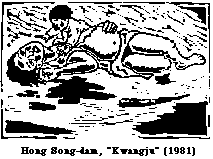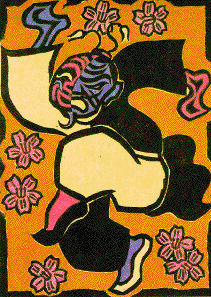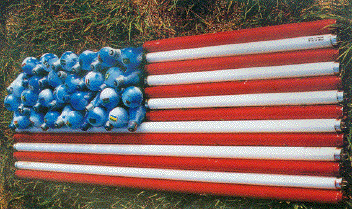 Minjung intellectuals were often accused of being communists, and although
many may have read Marxist-Leninist texts and Frankfurt School theorists,
they tried to indigenize socialist thinking. In contrast to the Marxist-Leninist
term "proletariat," minjung is defined neither as a
socio-economic
class or social group, nor by status or occupation; it is defined along
ethnocentric lines of argumentation. Without Marxian class distinctions,
the movement recruited most of its student activists from the urban middle
class. The bulk of writings in the 1980s focused on the expressions
minjung
and han (grievance, resentment, unsatisfied desire) along with a
handful of other terms, alleged to describe typical and unique characteristics
of the experience of the Korean nation and people (read race). Starting
with literature and theology, the movement became a full-fledged (though
never all-embracing) cultural movement in the early 1980s. In revitalizing
indigenous art forms, Minjung activists severely criticized the intellectual
elitism of the country's power elite and upper bourgeoisie, while at the
same time offering Utopian nativist visions of society, freedom and national
well-being in a reunified country. All these visions were, at base, anti-modern
and anti-Western.
Minjung intellectuals were often accused of being communists, and although
many may have read Marxist-Leninist texts and Frankfurt School theorists,
they tried to indigenize socialist thinking. In contrast to the Marxist-Leninist
term "proletariat," minjung is defined neither as a
socio-economic
class or social group, nor by status or occupation; it is defined along
ethnocentric lines of argumentation. Without Marxian class distinctions,
the movement recruited most of its student activists from the urban middle
class. The bulk of writings in the 1980s focused on the expressions
minjung
and han (grievance, resentment, unsatisfied desire) along with a
handful of other terms, alleged to describe typical and unique characteristics
of the experience of the Korean nation and people (read race). Starting
with literature and theology, the movement became a full-fledged (though
never all-embracing) cultural movement in the early 1980s. In revitalizing
indigenous art forms, Minjung activists severely criticized the intellectual
elitism of the country's power elite and upper bourgeoisie, while at the
same time offering Utopian nativist visions of society, freedom and national
well-being in a reunified country. All these visions were, at base, anti-modern
and anti-Western.
 Let us look briefly at the most important trends and transformations
in Minjung art: the first Minjung-like images appeared right after the Kwangju
Massacre and were replicated worldwide in hundreds of pamphlets and books
on human rights in South Korea. These works were done by Tomiyama Taeko,
a Japanese female artist with a long record on civilian and human rights
activities and a close friend of the poet and social critic Kim Chi-ha.
She had illustrated Kim's poem Rumors with lithographs, and the publication
was circulated widely within the ranks of the Korean opposition. She had
been involved in the Japanese labor movement, worked with Japanese coal
miners, and followed political emigrants to Latin America. After her return
to Japan, she established the feminist journal Asian Women's Liberation
and campaigned against Japanese sex tourism in Korea. Tomiyama's Kwangju
woodcut series offers a stunning depiction of crucial scenes from the events
of May 1980. As she told this author in 1983, much of her style at the time
came from her study of Käthe Kollwitz and German Expressionism. While
in Latin America she especially studied the works of the prominent Mexican
socialist artist David Alfaro Siqueiros, whose monumental murals, with their
mixture of realism and phantasmagoria and their strong depiction of grievance,
powerfully appealed to her. It is this same core group of artists that informed
the first generation of Korean Minjung artists. Of course, the application
of a genealogical model of linear artistic and ideological development,
either for establishing a heritage of outside influences or harking back
to a few socialist Korean print artists of the 1930s, whose works had not
been republished and had vanished from public memory by the early 1980s,
does not do justice to the enormously powerful visual language of Minjung
art.
Let us look briefly at the most important trends and transformations
in Minjung art: the first Minjung-like images appeared right after the Kwangju
Massacre and were replicated worldwide in hundreds of pamphlets and books
on human rights in South Korea. These works were done by Tomiyama Taeko,
a Japanese female artist with a long record on civilian and human rights
activities and a close friend of the poet and social critic Kim Chi-ha.
She had illustrated Kim's poem Rumors with lithographs, and the publication
was circulated widely within the ranks of the Korean opposition. She had
been involved in the Japanese labor movement, worked with Japanese coal
miners, and followed political emigrants to Latin America. After her return
to Japan, she established the feminist journal Asian Women's Liberation
and campaigned against Japanese sex tourism in Korea. Tomiyama's Kwangju
woodcut series offers a stunning depiction of crucial scenes from the events
of May 1980. As she told this author in 1983, much of her style at the time
came from her study of Käthe Kollwitz and German Expressionism. While
in Latin America she especially studied the works of the prominent Mexican
socialist artist David Alfaro Siqueiros, whose monumental murals, with their
mixture of realism and phantasmagoria and their strong depiction of grievance,
powerfully appealed to her. It is this same core group of artists that informed
the first generation of Korean Minjung artists. Of course, the application
of a genealogical model of linear artistic and ideological development,
either for establishing a heritage of outside influences or harking back
to a few socialist Korean print artists of the 1930s, whose works had not
been republished and had vanished from public memory by the early 1980s,
does not do justice to the enormously powerful visual language of Minjung
art.






However, because of Minjung intellectuals' ambiguous notion towards
nationalism and ethnicity, the first generation of Minjung artists were
severely criticized for using Western techniques and for following the
modalities of the modernist aesthetic.
 It was mostly in the visual media, in painting, prints, photography,
and sculpture, but also in cartoons, caricatures, book illustrations, pictorial
banners, etc.—art forms that were more or less neglected by Korean
modernists—through which Minjung artists expressed themselves. Most of
the early activist-artists worked either in a technically unrefined realist
style or in a reinvented and politicized folk style. These styles often
invoked religious iconography, especially Buddhist and shamanist images,
which were depicted in a potpourri of selected folk art elements and icons
of modern life. Images of the American flag, Coca-Cola bottles, or the
portraits of politicians, kept popping up to replace anticipated religious
symbols or historical figures. In terms of style, the strongest impetus came
from German Expressionism and Latin American Socialist Realism. Blending
Western visual techniques such as photomontage and collage with the narrative
forms of traditional Korean religious and folk painting, the work of
first-generation Minjung artists succeeded in launching rather shrill, often
satirical or grotesque criticism against the country's military regime and
the political-economic elite.
It was mostly in the visual media, in painting, prints, photography,
and sculpture, but also in cartoons, caricatures, book illustrations, pictorial
banners, etc.—art forms that were more or less neglected by Korean
modernists—through which Minjung artists expressed themselves. Most of
the early activist-artists worked either in a technically unrefined realist
style or in a reinvented and politicized folk style. These styles often
invoked religious iconography, especially Buddhist and shamanist images,
which were depicted in a potpourri of selected folk art elements and icons
of modern life. Images of the American flag, Coca-Cola bottles, or the
portraits of politicians, kept popping up to replace anticipated religious
symbols or historical figures. In terms of style, the strongest impetus came
from German Expressionism and Latin American Socialist Realism. Blending
Western visual techniques such as photomontage and collage with the narrative
forms of traditional Korean religious and folk painting, the work of
first-generation Minjung artists succeeded in launching rather shrill, often
satirical or grotesque criticism against the country's military regime and
the political-economic elite.
 The second generation moved gradually to the left, and the movement became
increasingly radical in its means and dogmatic in its political outlook.
At the end of 1982, the group Turong was established around Kim Pong-jun.
This and other new groups were much better trained ideologically. The Turong
Group had organized study and reading circles, and its members were well
versed in Marxist and other leftist theories. The visualized messages of
this second generation reflected a nativist form of socialism and, from
the mid-1980s, also embraced North Korea's chuch'e (self-reliance)
ideology, according to which the minjung are seen as the driving
forces and the living subjects of history and arts. Thus, the second generation
criticized the first for using Western modernist modes of expression, and
sought to replace these with Korean national art forms by employing what
they called the "living arts" (san misul ), incorporating
and modifying traditional Korean genres like mask dance and shamanistic
rituals.
The second generation moved gradually to the left, and the movement became
increasingly radical in its means and dogmatic in its political outlook.
At the end of 1982, the group Turong was established around Kim Pong-jun.
This and other new groups were much better trained ideologically. The Turong
Group had organized study and reading circles, and its members were well
versed in Marxist and other leftist theories. The visualized messages of
this second generation reflected a nativist form of socialism and, from
the mid-1980s, also embraced North Korea's chuch'e (self-reliance)
ideology, according to which the minjung are seen as the driving
forces and the living subjects of history and arts. Thus, the second generation
criticized the first for using Western modernist modes of expression, and
sought to replace these with Korean national art forms by employing what
they called the "living arts" (san misul ), incorporating
and modifying traditional Korean genres like mask dance and shamanistic
rituals.
 The works of the second generation were in turn accused of being too
heavily invested in depicting ideological struggle at the expense of aesthetic.
In the wake of major steps toward democratization and continued economic
prosperity, the third generation of artists is left with only one unfulfilled
collective goal—national reunification—of the movement's three great goals.
It is therefore not surprising to find Minjung artists now either focusing
on reunification and, in the process, shifting toward a technically upgraded,
highly sophisticated Socialist Realist style informed by North Korean agitprop,
as seen in the joint North-South "Korean Reunification Exhibition"
in Japan two years ago, or working their way into the mainstream.
The works of the second generation were in turn accused of being too
heavily invested in depicting ideological struggle at the expense of aesthetic.
In the wake of major steps toward democratization and continued economic
prosperity, the third generation of artists is left with only one unfulfilled
collective goal—national reunification—of the movement's three great goals.
It is therefore not surprising to find Minjung artists now either focusing
on reunification and, in the process, shifting toward a technically upgraded,
highly sophisticated Socialist Realist style informed by North Korean agitprop,
as seen in the joint North-South "Korean Reunification Exhibition"
in Japan two years ago, or working their way into the mainstream.
 Anyone visiting South Korea during the 1980s could see the pervasiveness
of the images of Minjung art—as cover illustrations, student banners and
murals, or strike placards. Minjung art first appeared in 1980, just after
the Kwangju Massacre. Never before in the Peninsula's history, or perhaps
anywhere else for that matter has art played such a prominent role in a
nation's drive to democratization. This was precisely why the intellectual
establishment attempted to counter its influence by declaring Minjung art
a non-art—subliminal propaganda devoid of aesthetic quality. Castigated
by mainstream scholarship and media (state endorsed or controlled) and ignored
by associated art journals and galleries until the democratic countdown
began in 1987, Minjung art nonetheless developed into a highly influential
and evocative force.
Anyone visiting South Korea during the 1980s could see the pervasiveness
of the images of Minjung art—as cover illustrations, student banners and
murals, or strike placards. Minjung art first appeared in 1980, just after
the Kwangju Massacre. Never before in the Peninsula's history, or perhaps
anywhere else for that matter has art played such a prominent role in a
nation's drive to democratization. This was precisely why the intellectual
establishment attempted to counter its influence by declaring Minjung art
a non-art—subliminal propaganda devoid of aesthetic quality. Castigated
by mainstream scholarship and media (state endorsed or controlled) and ignored
by associated art journals and galleries until the democratic countdown
began in 1987, Minjung art nonetheless developed into a highly influential
and evocative force.

 O Yun
O Yun



 Chon Mi-yong
Chon Mi-yong